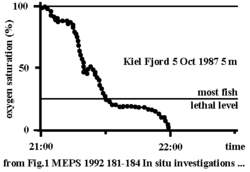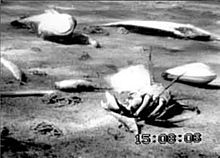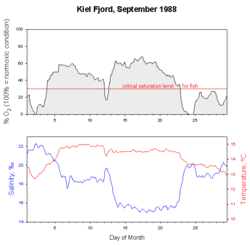- Hypoxia (environmental)
-
Hypoxia, or oxygen depletion, is a phenomenon that occurs in aquatic environments as dissolved oxygen (DO; molecular oxygen dissolved in the water) becomes reduced in concentration to a point where it becomes detrimental to aquatic organisms living in the system. Dissolved oxygen is typically expressed as a percentage of the oxygen that would dissolve in the water at the prevailing temperature and salinity (both of which affect the solubility of oxygen in water; see oxygen saturation and underwater). An aquatic system lacking dissolved oxygen (0% saturation) is termed anaerobic, reducing, or anoxic; a system with low concentration—in the range between 1 and 30% saturation—is called hypoxic or dysoxic. Most fish cannot live below 30% saturation. A "healthy" aquatic environment should seldom experience less than 80%. The exaerobic zone is found at the boundary of anoxic and hypoxic zones.
Contents
Where hypoxia occurs
Hypoxia can occur throughout the water column and also at high altitudes as well as near sediments on the bottom. It usually extends throughout 20-50% of the water column, but depending on the water depth and location of pycnoclines (rapid changes in water density with depth)[1] it can occur in 10-80% of the water column. For example, in a 10-meter water column, it can reach up to 2 meters below the surface. In a 20-meter water column, it can extend up to 8 meters below the surface.[2]
Hypoxia can also occur outside of an aquatic environment, in conditions where the oxygen content of the air is reduced. This is common, for example, in the sealed burrows of some subterranean animals, such as blesmols.[3]
Causes of hypoxia
 Decline of oxygen saturation to anoxia, measured during the night in Kiel Fjord, Germany. Depth = 5 m
Decline of oxygen saturation to anoxia, measured during the night in Kiel Fjord, Germany. Depth = 5 m
Oxygen depletion can result from a number of natural factors, but is most often a concern as a consequence of pollution and eutrophication in which plant nutrients enter a river, lake, or ocean, and phytoplankton blooms are encouraged. While phytoplankton, through photosynthesis, will raise DO saturation during daylight hours, the dense population of a bloom reduces DO saturation during the night by respiration. When phytoplankton cells die, they sink towards the bottom and are decomposed by bacteria, a process that further reduces DO in the water column. If oxygen depletion progresses to hypoxia, fish kills can occur and invertebrates like worms and clams on the bottom may be killed as well.
Hypoxia may also occur in the absence of pollutants. In estuaries, for example, because freshwater flowing from a river into the sea is less dense than salt water, stratification in the water column can result. Vertical mixing between the water bodies is therefore reduced, restricting the supply of oxygen from the surface waters to the more saline bottom waters. The oxygen concentration in the bottom layer may then become low enough for hypoxia to occur. Areas particularly prone to this include shallow waters of semi-enclosed water bodies such as the Waddenzee or the Gulf of Mexico, where land run-off is substantial. In these areas a so-called "dead zone" can be created. The World Resources Institute has identified 375 hypoxic coastal zones around the world, concentrated in coastal areas in Western Europe, the Eastern and Southern coasts of the US, and East Asia, particularly in Japan.[4]
Hypoxia may also be the explanation for periodic phenomena such as the Mobile Bay jubilee, where aquatic life suddenly rushes to the shallows, perhaps trying to escape oxygen-depleted water. Recent widespread shellfish kills near the coasts of Oregon and Washington are also blamed on cyclic dead zone ecology.[5]
Solutions
To combat hypoxia, it is essential to reduce the amount of land-derived nutrients reaching rivers in runoff. Defensively this can be done by improving sewage treatment and by reducing the amount of fertilizers leaching into the rivers. Offensively this can be done by restoring natural environments along a river; marshes are particularly effective in reducing the amount of phosphorus and nitrogen (nutrients) in water.
Technological solutions are also possible, such as that used in the redeveloped Salford Docks area of the Manchester Ship Canal in England, where years of runoff from sewers and roads had accumulated in the slow running waters. In 2001 a compressed air injection system was introduced, which raised the oxygen levels in the water by up to 300%. The resulting improvement in water quality led to an increase in the number of invertebrate species, such as freshwater shrimp, to more than 30. Spawning and growth rates of fish species such as roach and perch also increased to such an extent that they are now amongst the highest in England.[6]
In a very short time the oxygen saturation can drop to zero when offshore blowing winds drive surface water out and anoxic depthwater rises up. At the same time a decline in temperature and a rise in salinity is observed (from the longterm ecological observatory in the seas at Kiel Fjord, Germany). New approaches of long-term monitoring of oxygen regime in the ocean observe online the behavior of fish and zooplankton, which changes drastically under reduced oxygen saturations (ecoSCOPE) and already at very low levels of water pollution.
Bog chemistry
In certain northern European sphagnum acidic bogs, a condition of hypoxia arises that prevents tissue decay by impeding micro-organisms in the soil and groundwater. Remarkable preservation of human mummies has occurred in some cases such as the discovery of Haraldskær Woman and Tollund Man in Jutland, Denmark and Lindow man in Cheshire, England.
See also
- Algal blooms
- Anoxic event
- Dead zone (ecology)
- Denitrification
- Eutrophication
- Fish kill
- Oxygen saturation
- Wastewater quality indicators discusses both BOD and COD as measures of water quality.
- Winkler test for dissolved oxygen — for instructions on how to determine the amount of oxygen dissolved in fresh water.
References
- ^ Reference.com <http://www.reference.com/search?q=Pycnocline>.
- ^ Rabalais, Nancy; Turner, R. Eugene; Justic´, Dubravko; Dortch, Quay; Wiseman, William J. Jr. Characterization of Hypoxia: Topic 1 Report for the Integrated Assessment on Hypoxia in the Gulf of Mexico. Ch. 3. NOAA Coastal Ocean Program, Decision Analysis Series No. 15. May 1999. < http://oceanservice.noaa.gov/products/hypox_t1final.pdf>. Retrieved February 11, 2009.
- ^ Roper, T.J. et al. (2001). "Environmental conditions in burrows of two species of African mole-rat, Georychus capensis and Cryptomys damarensis". Journal of Zoology 254 (1): 101–107. doi:10.1017/S0952836901000590.
- ^ Selman, Mindy (2007) Eutrophication: An Overview of Status, Trends, Policies, and Strategies. World Resources Institute.
- ^ oregonstate.edu – Dead Zone Causing a Wave of Death Off Oregon Coast (8/9/2006)
- ^ Hindle, P.(1998) (2003-08-21). "Exploring Greater Manchester — a fieldwork guide: The fluvioglacial gravel ridges of Salford and flooding on the River Irwell" (pdf). Manchester Geographical Society. http://www.mangeogsoc.org.uk/egm/5_1.pdf. Retrieved 2007-12-11. p.13
- Kils, U., U. Waller, and P. Fischer (1989). "The Fish Kill of the Autumn 1988 in Kiel Bay". International Council for the Exploration of the Sea. C M 1989/L:14.
- Fischer P. and U. Kils (1990). "In situ Investigations on Respiration and Behaviour of Stickleback Gasterosteus aculeatus and the Eelpout Zoaraes viviparus During Low Oxygen Stress". International Council for the Exploration of the Sea. C M 1990/F:23.
- Fischer P., K. Rademacher, and U. Kils (1992). "In situ investigations on the respiration and behaviour of the eelpout Zoarces viviparus under short term hypoxia". Mar Ecol Prog Ser 88: 181–184. doi:10.3354/meps088181.
External links
- Hypoxia in the Gulf of Mexico
- Dead zone in front of Atlantic City
- Hypoxia in Oregon Waters
- How Much Aeration Do I Need
Marine pollution - Algal bloom
- Anoxic event
- Anoxic waters
- Aquatic toxicology
- Cultural eutrophication
- Cyanotoxin
- Environmental impact of shipping
- Eutrophication
- Fish diseases and parasites
- Fish kill
- Friendly Floatees
- Great Pacific Garbage Patch
- Hypoxia
- Invasive species
- Marine debris
- Mercury in fish
- Nonpoint source pollution
- North Atlantic Garbage Patch
- Nutrient pollution
- Ocean acidification
- Ocean deoxygenation
- Oil spill
- Particle
- Plastic particle water pollution
- Point source pollution
- Shutdown of thermohaline circulation
- Stormwater
- Surface runoff
- Upwelling
- Urban runoff
- Water pollution
Aquatic ecosystems – general and freshwater components General - Aquatic ecosystems
- Acoustic ecology
- Agent-based models
- Algal bloom
- Anoxic waters
- Aquatic adaptation
- Aquatic animals
- Aquatic biodiversity research
- Aquatic biomonitoring
- Aquatic insects
- Aquatic layers
- Aquatic mammals
- Aquatic plants
- Aquatic predation
- Aquatic respiration
- Aquatic science
- Aquatic toxicology
- Benthos
- Bioluminescence
- Biomass
- Cascade effect
- Colored dissolved organic matter
- Dead zone
- Ecohydrology
- Eutrophication
- Fisheries science
- Food chain
- Food web
- GIS and aquatic science
- Hydrobiology
- Hypoxia
- Isotope analysis
- Microbial ecology
- Microbial food web
- Microbial loop
- Nekton
- Neuston
- Particle
- Photic zone
- Phytoplankton
- Plankton
- Productivity
- Ramsar Convention
- Schooling
- Sediment trap
- Siltation
- Spawning
- Substrate
- Thermal pollution
- Trophic level
- Underwater camouflage and mimicry
- Water column
- Zooplankton
- More...

Freshwater - Freshwater ecosystems
- Brackish marsh
- Freshwater biology
- Freshwater biomes
- Freshwater fish
- Freshwater marsh
- Freshwater swamp forest
- Hyporheic zone
- Lake ecosystems
- Landscape limnology
- Limnology
- Lake stratification
- Macrophyte
- Pond
- Fish pond
- Rheotaxis
- River ecosystems
- Stream bed
- Stream pool
- Trophic state index
- Upland and lowland
- Water garden
- Wetland
- Environmental quality
- More...
Ecoregions - Freshwater ecoregions
- List of freshwater ecoregions
- Marine ecoregions
- List of marine ecoregions
- Ecology of the Everglades
- Ecology of the San Francisco Estuary
- Ecosystem of the North Pacific Subtropical Gyre
- Freshwater ecology of Maharashtra
Aquatic ecosystems – marine components Marine 
Marine
life forms- Census of Marine Life
- Coastal fish
- Coral reef fish
- Deep sea communities
- Deep sea creature
- Deep sea fish
- Deep water corals
- Demersal fish
- Marine bacteriophage
- Marine invertebrates
- Marine larval ecology
- Marine mammal
- Marine reptile
- Marine vertebrate
- Paradox of the plankton
- Pelagic fish
- Seabird
- Seashore wildlife
- Wild fisheries
Marine
habitats- Bay mud
- Black smokers
- Coastal biogeomorphology
- Cold seeps
- Coral reefs
- Davidson Seamount
- Estuaries
- Intertidal ecology
- Intertidal wetland
- Kelp forests
- Hydrothermal vent
- Lagoons
- Mangroves
- Marine biomes
- Marine habitats
- Mudflat
- Rocky shores
- Salt marshes
- Seagrass meadows
- Sponge reefs
- Tide pools
Issues - Ecological values of mangrove
- Fisheries and climate change
- HERMIONE
- Marine conservation
- Marine conservation activism
- Marine pollution
- Marine Protected Area
Categories:- Aquatic ecology
- Chemical oceanography
- Environmental science
- Water quality indicators
- Oxygen
Wikimedia Foundation. 2010.



